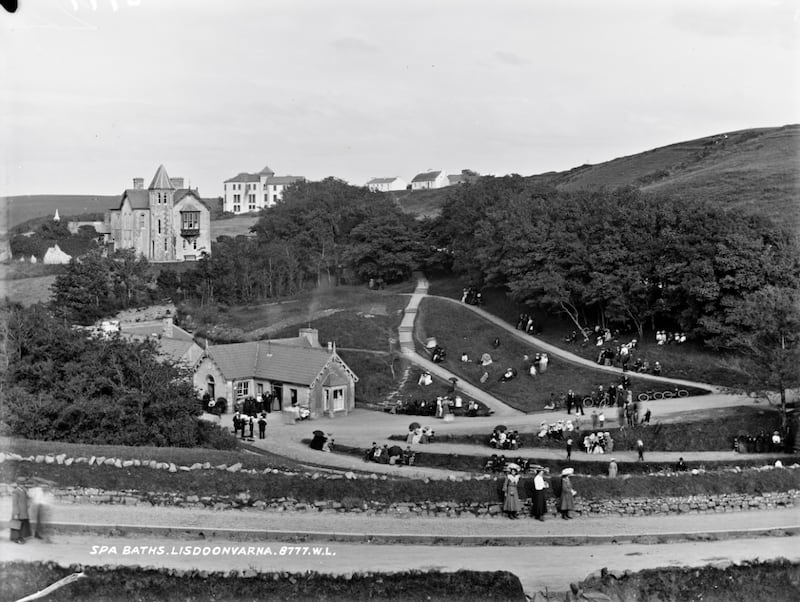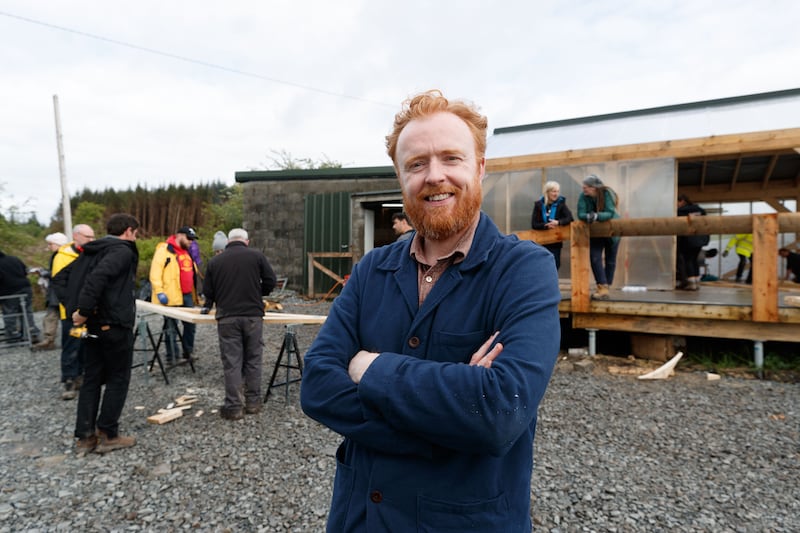“When I was growing up, we would see the whole town filling up from May to September and it was a fantastic thing to witness,” says Grafton Architects’ Shelley McNamara of her native Lisdoonvarna, Co Clare. “As we were walking to school, we would meet people walking down what we call sulphur hill, down to the baths.
“And if you’ve ever had a sulphur bath, you would know how beautiful it is,” she says.
Located between the Burren National Park and the Cliffs of Moher, Lisdoonvarna was established as a spa town thanks to the natural mineral waters found in the area. Two wealthy landowning families, the Creaghs and the Stackpools, were the first to settle there, according to former teacher and local historian John Hehir.
The town became a high-end Victorian holiday destination, and people would come from far and wide to drink or bathe in its mineral waters believed to contain sulphur, iron, magnesia and copper, which were promoted at the time to benefit “every known ailment you could ever think of”, says Hehir, citing rheumatism and fatigue as two examples.
READ MORE
Still standing today is the imposing old bath house where, McNamara describes, people would soak in free-standing ceramic tubs filled with the natural waters for about 15 minutes before hoisting themselves out with the aid of a sturdy rope attached to the ceiling. After a snooze on the daybed, the bather would wake up refreshed with tingling skin and a feeling of rejuvenation, she says.
“That’s what people came for; they came to the spa because of the wells,” says McNamara. “People danced and bathed and walked and sang,” she says. “It was very sociable and convivial, and there was romance in the air.”

In fact, many a young eligible “miss” and “master” were introduced to those considered “suitable matches” on their holidays in Lisdoonvarna in the early 20th century, according to Hehir, and local newspapers would list the who’s who of those arriving and departing the town on a weekly basis. The town’s matchmaking tradition lives on through an annual festival held in September.
In Lisdoonvarna to discuss an app his company is developing for visitors to the town, Ivan Tuohy of Great Visitor Experiences says he has a vivid memory of visiting the spa wells as a child: “We used to come to Lisdoonvarna always in September because there were big barbecues and all that sort of thing, but the smell of sulphur and eggs was so strong, it was unbelievable,” he says.
[ The two Irish women among the world’s top architectsOpens in new window ]
“The wells were open, and Dad used to do the baths and my mother would be throwing her eyes up to heaven,” says Tuohy.
Birgitta Hedin-Curtin, owner of artisanal smoked salmon producer Burren Smokehouse, and whose husband, Peter Curtin, owns the Roadside Tavern gastropub and microbrewery in the town, says she once drank the sulphur waters herself but laughs when asked to describe how she felt afterwards. “Well, I didn’t feel unwell beforehand, so it wasn’t for anything medical,” she says. “I suppose you would feel a bit better after it, depending [on what you need].”

The town’s popularity began to decline with the arrival of package holidays to far-flung places in the late 1960s and early 1970s. “People stopped coming, it was a very sad time and a difficult time for the town,” says McNamara. “The season kept contracting and contracting and it ended up just being one month and focusing primarily on matchmaking because the wells were not in operation to the same level.”
Lisdoonvarna has been struggling to capitalise on its location and natural resources ever since and the town has also experienced a lot of change over the decades, most notably the fact that its population of 900 has more than doubled in recent years, according to Fine Gael councillor and interim chairman of Lisdoonvarna Fáilte Joe Garrihy. A total of 1,300 people fleeing war in Ukraine have arrived in the town since 2022, most of whom now occupy two of its largest hotels. A direct provision centre housing international protection applicants also opened in 2018, adding about 100 people to the town’s population.

Anastasiia Bloshchynska (32) from Brovary, Ukraine, who arrived in August 2022, now works for Lisdoonvarna Fáilte, the group tasked with running the 80 acres of land owned by the town on behalf of a trust. Coming from a city, it has been a difficult transition to live in a rural part of Clare where buses to Ennis don’t run late enough to catch an evening showing at the cinema. “But I’m happy for everything,” she says, citing “the safety, and the comfy feeling that you’re in a safe place.”
In an effort to bring the community together to work toward a common goal and reflect the multicultural town as it now is, Fionn Kidney, co-founder of Common Knowledge, brought the Irish Architecture Foundation’s Hometown Architect programme to the attention of McNamara. The pair had previously been acquainted after McNamara extended support to Kidney and his co-founder Harrison Gardner, author of Build Your Own, when they set up the social enterprise 3km outside of Lisdoonvarna, Common Knowledge, which is focused on teaching sustainable skills such as house building, willow weaving and wood turning.

The Hometown Architect programme, which is accepting a fresh batch of applications until January 19th, granted €10,000 each to five communities to fund a collaboration project between a local architect and those in the community to rejuvenate towns around the country. When Kidney approached McNamara, she didn’t hesitate to get involved: “I haven’t spent much time there, especially since my parents died, I’ve been there hardly at all in the past 10 years, so it’s been fantastic to have a reason to come back, not just for a funeral or some sad occasion; to come back and find these new energies that exist, and new problems. It was really important for me.”
McNamara along with Kidney; Kevin Loftus of Act (Accelerating Change Together), a collective of architects, urbanists and policy specialists; Lisdoonvarna Fáilte; and people from all corners of the community met in the local Pavilion hall on three occasions to discuss their hopes for the town as part of the Hometown Architect scheme, culminating in a nine-point vision “rooted in the spa town’s heritage of wellbeing” entitled Tapping the Well.
“There was a huge map [of Lisdoonvarna] pinned on the wall,” McNamara says. “It was used as a means of connection and we gave everybody pencils and pens and people were drawing on [individual] maps, writing their ideas on it. It acts as a focus; it wasn’t just words.
“What we discovered is the town doesn’t need new ingredients; it needs all of the existing resources to be revived and renewed because it’s full of existing resources that are quite unique in Ireland, [notably] the spa wells,” she says. “Lisdoonvarna was fantastic, and it can be fantastic again.”
Kidney says: “For us, our involvement is an expression of our commitment to being part of a future here. I feel the community has really come together behind the big ambitions that are in here,” he says, tapping on a bound printout of the vision document.
The nine-point vision focuses on the promotion of Lisdoonvarna as a place of wellbeing, incorporating the reopening of the spa wells, in an aim to give visitors going to established nearby heritage sites such as the Cliffs of Moher and the Burren a reason to spend time – and, of course, money – in Lisdoonvarna. Its central location, the document suggests, would allow it to become a north Clare hub for those visiting the area. There was also a focus on improving the town for local people by reviving the central town square as a social spot and improving walking routes.
“Before learning about plans for the spa wells, I was thinking oh my God it’s such a beautiful place with beautiful architecture. I was mesmerised with it, especially the big Victorian doctor’s house [Maiville House],” says Bloshchynska. “The spa wells is my favourite place when it’s warm to sit on a bench, drink coffee and talk.
“I think we could be famous if we can connect the history with modern spa procedures,” she adds. “I would want to renovate them, not rebuild, because they are so beautiful, and tourists would like to come to see them.”
Kidney points out a key recommendation from the vision document is to create a “town team” of people from different groups to work towards its goals, for which Garrihy of Lidoonvarna Fáilte says expressions of interest are being sought.

The 80 acres of town-owned lands include the spa wells complex and buildings, a creche, the Pavilion hall, and the North Clare Sport and Amenity Park which has sport pitches, a playground and a heritage trail leading from the spa wells to a site at the other end of the town known as the “twin wells”. A local woman and Irish speaker, believed to have lived until about 1900, gained the nickname Biddy the Sulphur for dispensing cups of the mineral waters to holidaymakers from the twin wells “for a penny or 2 pence”, says Hehir. Completed in 2023, a riverside park now gives access to the twin wells and Lisdoonvarna Fáilte hopes to erect a piece of art there in Biddy’s memory. The waters, however, are no longer being consumed and Garrihy says he would like to have them tested before suggesting anyone venture to have a drink.
“With someone like Joe [Garrihy] and Lisdoonvarna Fáilte there to drive things forward now, it feels like there’s funding out there so it’s just a matter of translating [the vision] into packages of work,” says Kidney. “Lisdoonvarna is lucky to have that.”
One of the things that struck McNamara most was the local transition-year students she spoke to who said they passionately wanted to stay in Lisdoonvarna and find work there.
One young man from the area who is planning to set up his life in the town is Conor Burke, an art teacher in the local secondary school who has established a letterpress printing facility there, called Gentian Press, where he creates limited-edition books. Burke, who is a graduate in graphic design from the National College of Art and Design in Dublin, hopes to expand the facility to create studio space for artists in the building that was once McNamara’s father’s joinery.
[ Róisín Ingle: What makes the Burren the best place to holiday in Ireland 2022?Opens in new window ]
McNamara says she found the process of immersing herself in the community of her homeplace “quite emotional”.
“I’m an insider but also an outsider, and there’s a certain freedom in that,” she says.
“You realise that as an architect the Lisdoonvarna I remember is kind of a symbol and a model that I often draw from,” says McNamara. “When it was thriving, it was so joyful and full of music and dancing and health and wellbeing and people walking and farmers having their tired bodies renewed after the harvest and professionals in posh hotels with beautiful ballrooms.
“As architects we don’t think of time as linear, we’re always reaching into the ancient past to find solutions for the future. And I think there’s an awful lot of value in what Lisdoonvarna has and did have in terms of a model for a community for the future.”
- Sign up for push alerts and have the best news, analysis and comment delivered directly to your phone
- Find The Irish Times on WhatsApp and stay up to date
- Our In The News podcast is now published daily – Find the latest episode here




















